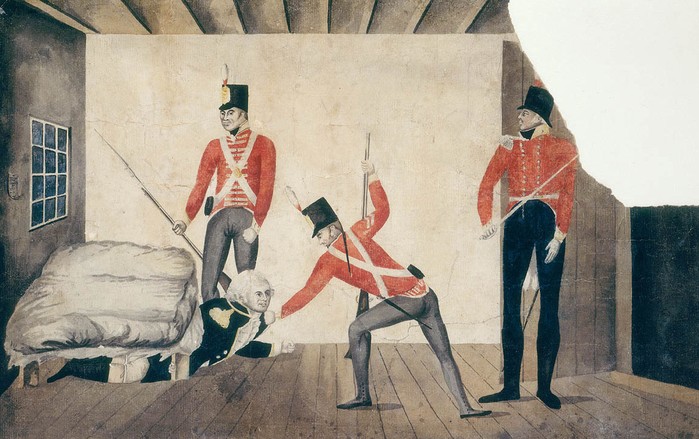The arrest of Governor Bligh
Watercolour
Safe 4 / 5
Presented 1891
This iconic early colonial
watercolour ‘cartoon’ is believed to have been commissioned by Sergeant Thomas
Whittle, a N.S.W. Corps soldier, just hours after the event and displayed in his
home a couple of days after the Governor’s arrest, to show Bligh’s cowardice. The uniformed officer in the centre of the painting is thought
to be Major George Johnston, senior officer of the N.S.W. Corps, who
ordered Bligh's arrest. Attached to the left hand wall is a sheet with the motto, 'O [dear] what can the matter be', from a traditional English nursery
rhyme.
The scene depicted in Friend's version
By Margot Riley
The scene depicted in Friend’s version shows the interior of
Sydney’s First Government House (now the site of the Museum of Sydney) facing
onto Bligh Street. A room, replete with furnishings, is littered with miniature
allegorical details; a four poster bed and patterned floor covering, a couple
of framed pictures hanging on the wall including a double hemisphere map.
Through the window and door a vista sweeps down onto Sydney Cove, the present
site of Circular Quay, and across to The Rocks. A uniformed officer, arms raised
in the act of issuing orders, stands in the doorway as two red-coated NSW
Corpsmen (one holding a rifle) charge across the room to wrestle a man in
shirtsleeves (Bligh) out from under the bed.
The original source document for Friend's version
By Margot Riley
As a young artist, studying the collections of Sydney’s local cultural institutions, Donald Friend would certainly have been aware of the State Library’s famous 1808 ‘cartoon’ of ‘Bligh under the bed’. The only contemporary visual documentation of this complex early colonial political event, it is clearly the original source document for Friend’s own version of ‘The Arrest of Governor Bligh’, c. 1965.
The arrest of Governor Bligh by Donald Friend, c. 1965
By Margot Riley
This decorative panel painting presents a
colourful reimagining of Australia’s one and only military coup, some 160 years
after the event. Based on the original colonial watercolour held in the
Mitchell Library, it was created by Donald Friend, a Sydney-born painter,
draughtsman, printmaker, sculptor, illustrator, director and writer. Friend
completed a number of similar works around this time focusing on aspects of
Australian history including a 10 panel 'Bennelong' series (1964) for the
Sydney Opera House.
As a young artist, studying the collections of Sydney’s local
cultural institutions, Donald Friend would certainly have been aware of the State
Library’s famous 1808 ‘cartoon’ of ‘Bligh under the bed’. The only contemporary
visual documentation of this complex early colonial political event, it is clearly
the original source document for Friend’s own version of ‘The Arrest of
Governor Bligh’, c. 1965.
A clash between two authorities
By Margot Riley
This single, simplistic cartoon represents a
clash between two authorities – civil and military – and is the only image that
records the entire political history of the complex chain of events leading up to Australia’s only military
coup. The so-called Rum Rebellion occurred on 26 January 1808, during which the
rule of William Bligh (1754–1817), the fourth Governor of New South Wales, was
overthrown by Major George Johnston, senior officer of the NSW Corps.
Bligh had been appointed Governor of New
South Wales on 14 May 1805, with orders to clean up the corrupt rum trade of
the New South Wales Corps. Taking up the office in Sydney on 13 August 1806, Bligh
swiftly began carrying out his orders but in so doing made many powerful
enemies both within the corps and the set of settler ‘exclusives’ who
controlled the trade in rum on which the
colonial economy was run.
Early on the evening of 26 January, spurred
on by John Macarthur and with no legal authority, Major George Johnston declared
himself Lieutenant-Governor and marched on Government House watched by 200
onlookers. After a long search through the property, Bligh was arrested and
deposed by Johnston who declared martial law — Bligh was reputed to have been
found hiding under a bed.
Having been placed on public exhibition,
ensconced between two candlesticks at Whittle’s home, shortly after the event,
the drawing was presumably later presented to Major Johnson as a souvenir. In
1891, the watercolour was subsequently presented by the Johnston Family of
Annandale, descendants of Colonel George Johnston, to the National Art Gallery
(Art Gallery of NSW, Sydney). The Illustrated
Sydney News reported, 'A very interesting addition has been made to the
National Art Gallery collection by Mrs Fanny Johnston of Annandale, who has
presented the Government of New South Wales with the original family oil
paintings and a number of relics, all of which are objects of historic value in
connection with the early settlement of Australia.’ In a letter accompanying
her gift and addressed to Sir Henry Parkes, Mrs Johnston wrote, ‘It is the wish
of myself and family that…these mementoes will be held in perpetuity on behalf
of the Australian people.’ (Illustrated
Sydney News, 19 December 1891, p20).



 Back to list
Back to list